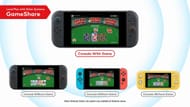The Nintendo Switch 2 is only a few months away from its release. The Japanese giants have shared many new features, building the hype around the hybrid console. Two of these that grabbed a lot of attention were GameShare and the Virtual Game Card, both of which make it easier for Nintendo users to share their games with others.
However, some gamers may be confused about the two game sharing options on the Switch 2. This article explains their differences and details which is the better choice.
What's the difference between GameShare and Virtual Game Card?
GameShare is a local multiplayer feature that lets one player share a game with up to three others as long as they are on the same network. Only the owner needs to own the game; however, if they disconnect, access is lost.
GameShare also includes GameChat, which allows players to see each other’s progress. Currently, selected titles are receiving support for this feature. While the original Switch and Switch Lite can receive shared games from a Switch 2, only Switch 2 users can share them.
Virtual Game Card brings digital game sharing closer to the flexibility of physical cartridges. When a player buys a digital game, they can "eject" it from their library and load it to another system. A one-time local wireless connection is required for sharing, and family members in a Nintendo Account Family Group can also borrow games.
Family sharing allows lending to up to eight accounts, although each title can only be shared with one person at a time. Additionally, a borrowed game remains on the recipient’s console for up to two weeks before automatically returning to the owner’s account.
Which Nintendo Switch 2 game sharing feature is better?
Both options offer unique benefits. GameShare is ideal for local multiplayer sessions since it allows multiple people to play a game together without having to make additional purchases. However, its reliance on a shared network and game availability restrictions may be limiting.

On the other hand, Virtual Game Card is better suited for long-term sharing, particularly for those who want to lend digital games like physical copies. The two-week lending period and one person playing a game at a time are major drawbacks. However, it offers flexibility to digital game ownership for Nintendo Switch 2 users.
Choosing between GameShare and Virtual Game Card depends on your requirements. If you primarily play with friends at the same place, GameShare is the better choice option.
However, Virtual Game Card would suit you if you want more freedom with digital games and the ability to lend them like physical copies. Either way, the Nintendo Switch 2 makes game sharing easier than ever.
